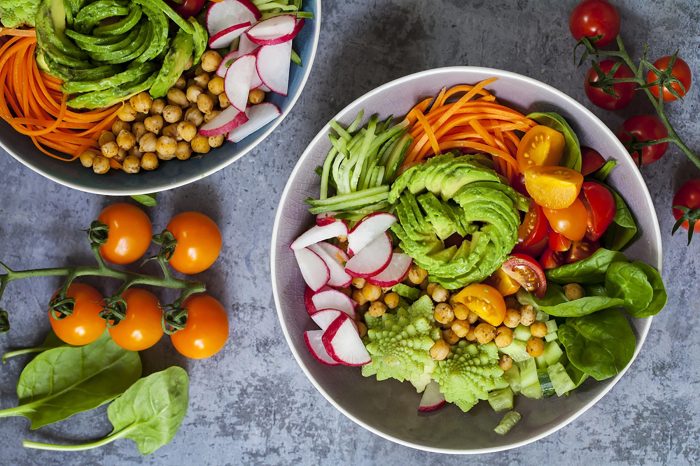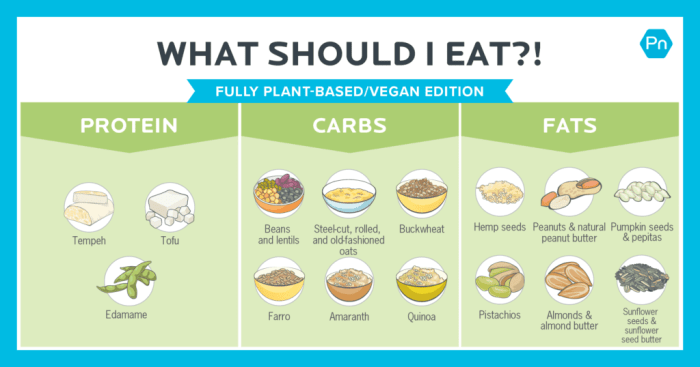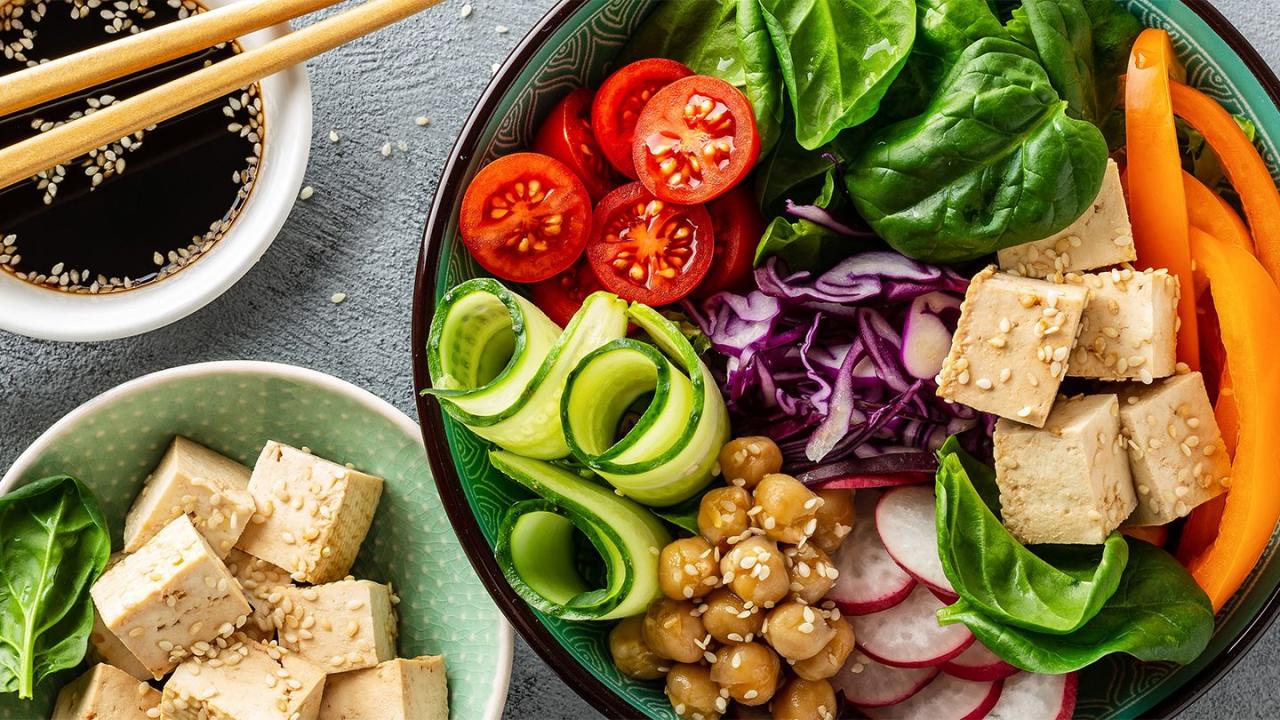How to eat a vegan diet – Embark on a culinary adventure with our comprehensive guide to veganism, empowering you to embrace a plant-based lifestyle that nourishes your body and aligns with your values. Discover the secrets to creating balanced and satisfying meals, exploring the diverse world of vegan substitutes, and understanding the ethical and environmental implications of your dietary choices.
Nutritional Considerations for a Vegan Diet
Adhering to a vegan diet necessitates meticulous attention to nutritional intake to guarantee the consumption of essential nutrients that are typically obtained from animal products. These vital elements include protein, iron, and vitamin B12, among others.
Plant-based sources, such as legumes, lentils, tofu, and fortified plant-based milk, can provide adequate protein for vegans. Iron can be obtained from leafy green vegetables, beans, and fortified cereals. Vitamin B12, however, is exclusively found in animal products, making supplementation or consumption of fortified foods crucial for vegans.
Potential Risks and Benefits of Veganism, How to eat a vegan diet
While a well-planned vegan diet can offer health benefits, such as reduced risk of heart disease and certain types of cancer, it also carries potential risks if not executed properly.
Embracing a vegan lifestyle requires careful planning and knowledge. By following a comprehensive guide to veganism , you’ll learn about essential nutrients, protein sources, and meal ideas. With proper planning, you can enjoy a fulfilling and nutritious vegan diet that supports your health and aligns with your ethical values.
- Vitamin B12 deficiency:As mentioned earlier, vitamin B12 is not naturally found in plant-based foods, and deficiency can lead to anemia and neurological problems.
- Inadequate protein intake:Protein is essential for muscle growth and repair. Vegans need to be mindful of consuming sufficient protein from plant-based sources to meet their daily requirements.
- Potential for nutrient deficiencies:A poorly planned vegan diet may lack certain nutrients, such as calcium, iron, and omega-3 fatty acids, which can lead to health issues if not supplemented or obtained from fortified foods.
Conversely, a well-balanced vegan diet has been associated with numerous health benefits, including:
- Reduced risk of heart disease:Plant-based diets are typically lower in saturated fat and cholesterol, which can contribute to lower levels of LDL (“bad”) cholesterol.
- Lower risk of certain types of cancer:Studies have shown that vegans have a lower risk of developing certain types of cancer, such as colon and prostate cancer.
- Improved blood sugar control:Plant-based diets are rich in fiber, which can help regulate blood sugar levels and reduce the risk of type 2 diabetes.
Meal Planning and Food Sources

Meal planning is essential for a healthy vegan diet. By planning your meals ahead of time, you can ensure that you are getting all the nutrients you need. When creating vegan meals, it is important to include a variety of plant-based protein sources, fruits, vegetables, and whole grains.
Some good sources of plant-based protein include beans, lentils, tofu, tempeh, and nuts. Fruits and vegetables are good sources of vitamins, minerals, and antioxidants. Whole grains are a good source of fiber and complex carbohydrates.
Sample Vegan Meal Plan
Here is a sample vegan meal plan for a day:
- Breakfast:Oatmeal with fruit and nuts
- Lunch:Salad with grilled tofu, quinoa, and vegetables
- Dinner:Lentil soup with whole-wheat bread
- Snacks:Fruit, vegetables, nuts, and seeds
Cooking Techniques for Vegan Cuisine
Mastering a range of cooking techniques is crucial for creating flavorful and satisfying vegan dishes. This guide will delve into essential methods, from stir-frying to roasting, providing tips and tricks to elevate your vegan culinary skills.
Stir-Frying
Stir-frying is a versatile technique that allows for quick and flavorful cooking. Heat a large skillet or wok over high heat, add a drizzle of oil, and toss in your chopped vegetables or plant-based protein. Stir constantly to prevent burning, ensuring even cooking.
Season with your favorite herbs and spices to enhance the flavors.
Roasting
Roasting is a great way to caramelize vegetables and bring out their natural sweetness. Preheat your oven to the desired temperature, toss your vegetables with oil, salt, and pepper, and spread them evenly on a baking sheet. Roast until tender and slightly browned, flipping them halfway through the cooking time.
Embracing a vegan lifestyle can be a transformative experience. Whether you’re motivated by ethical concerns, environmental impact, or personal health, discovering how to have a vegan diet is essential. Transitioning to a plant-based diet involves understanding the principles of veganism, navigating food choices, and finding support along the way.
By exploring resources, connecting with like-minded individuals, and seeking professional guidance if needed, you can embark on this journey with confidence and reap the numerous benefits it has to offer.
Blending
Blending is an essential technique for creating creamy sauces, dips, and smoothies. Use a high-powered blender to combine your ingredients until smooth and desired consistency is achieved. Add liquids as needed to adjust the thickness.
Substituting Vegan Ingredients
Substituting traditional animal products with vegan alternatives is key in vegan cooking. Here are some common substitutions:
- Plant-based milk:Soy milk, almond milk, or oat milk can replace dairy milk in recipes.
- Vegan butter:Margarine, plant-based butter substitutes, or mashed avocado can replace butter.
- Vegan cheese:Nut-based cheeses, soy-based cheeses, or nutritional yeast can provide a cheesy flavor.
Vegan Substitutes and Alternatives

Embracing a vegan lifestyle necessitates the exploration of plant-based alternatives to familiar animal products. Fortunately, the market offers an array of vegan substitutes that mimic the taste and texture of their dairy counterparts, ensuring a seamless transition for vegans.
Vegan substitutes not only provide a delicious and convenient option but also boast nutritional benefits. Many plant-based milk alternatives are fortified with calcium, vitamin D, and other essential nutrients, making them comparable to dairy milk in terms of nutritional value.
Plant-Based Milk Alternatives
- Soy Milk:A popular choice due to its high protein content and neutral flavor, making it suitable for various culinary applications.
- Almond Milk:A low-calorie option with a nutty flavor, ideal for smoothies and cereal.
- Oat Milk:Creamy and slightly sweet, oat milk is a versatile choice for both cooking and baking.
- Coconut Milk:Rich and flavorful, coconut milk is an excellent substitute for dairy in soups, curries, and desserts.
Vegan Cheese Alternatives
- Soy Cheese:Made from fermented soybeans, soy cheese has a similar texture to cheddar or mozzarella and can be used in sandwiches, pizzas, and salads.
- Almond Cheese:A creamy and tangy alternative made from almonds, ideal for spreads and dips.
- Cashew Cheese:Rich and flavorful, cashew cheese is a versatile option that can be used in a variety of dishes.
- Nutritional Yeast Cheese:A unique alternative with a cheesy flavor and a nutritional boost due to its high vitamin B12 content.
Vegan Yogurt Alternatives
- Soy Yogurt:A protein-rich alternative with a similar texture to dairy yogurt, suitable for smoothies, parfaits, and dips.
- Coconut Yogurt:A creamy and flavorful option made from coconut milk, providing a tropical twist to desserts and snacks.
- Almond Yogurt:A low-calorie and nutty alternative, ideal for breakfast bowls and smoothies.
- Cashew Yogurt:A rich and tangy alternative that can be used in various culinary applications.
Ethical and Environmental Implications

Veganism is not just a dietary choice but also a lifestyle motivated by ethical and environmental concerns. It advocates for the protection of animals and the preservation of the planet.
Animal agriculture poses significant ethical dilemmas. Factory farming, a prevalent practice, subjects animals to inhumane conditions, including overcrowding, lack of proper care, and painful mutilations. Veganism offers a compassionate alternative, rejecting the exploitation and suffering of animals for food.
Environmental Impact
Animal agriculture also has a devastating impact on the environment. It is a major contributor to greenhouse gas emissions, deforestation, water pollution, and land degradation. Livestock production requires vast amounts of land, water, and feed, putting a strain on natural resources.
Veganism promotes sustainability by reducing the demand for animal products. By choosing plant-based foods, individuals can significantly lower their carbon footprint, conserve water, and protect forests. It is a powerful way to combat climate change and safeguard the planet for future generations.
Resources
- Animal Equality: https://animalequality.org/
- Mercy for Animals: https://mercyforanimals.org/
- Environmental Defense Fund: https://www.edf.org/
- The Vegan Society: https://www.vegansociety.com/
Epilogue: How To Eat A Vegan Diet
Whether you’re a seasoned vegan or curious about exploring plant-based eating, this guide provides a wealth of knowledge and inspiration. By embracing the principles of veganism, you can not only enhance your health but also contribute to a more sustainable and compassionate world.
FAQ Insights
What are the essential nutrients to consider on a vegan diet?
Protein, iron, vitamin B12, calcium, and omega-3 fatty acids are crucial nutrients to ensure adequate intake on a vegan diet.
How can I get enough protein as a vegan?
Plant-based sources of protein include beans, lentils, tofu, tempeh, nuts, and seeds.
What are some common vegan substitutes for dairy products?
Plant-based milk (almond, soy, oat), vegan cheese, and yogurt made from soy, coconut, or cashew are popular dairy alternatives.